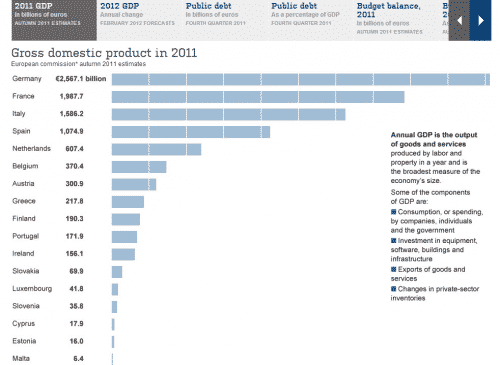Chart of the Day: Euro zone GDP by country
This chart was attached to a very good front page article in today’s Wall Street Journal by Marcus Walker on How a Radical Greek Rescue Plan Fell Short. The article gives a blow-by-blow account on how the Greek crisis has unfolded and a detailed view on where each of the Greek and European leaders stood on various issues involved in Greece’s debt restructuring.
The chart itself demonstrates the enormous gulf between the size of the German economy and other economies in Europe, giving some sense of why the Germans (and the French) have come to dominate European policy discussions. When I look at the chart, I see four countries that are clearly too big to fail: Germany, France, Italy and Spain. I also see a number of countries which carry little weight economically. I would put the cutoff at Slovakia with a GDP of just under 70 billion euros. For comparison sake, this is a GDP on par with the city of Washington DC or the state of Arkansas.
On the other hand Ireland, Portugal, and Greece are middling size economies in Europe, about as big as US states like Connecticut or Arizona, but all clearly smaller than Michigan or Massachusetts. They matter, but just not as much as the big four economies in the euro zone. For me, this fact definitely shapes how Europe responds to crisis. A problem in Spain, with an economy bigger than every US state except California, is of a different order of magnitude than a similar problem in Ireland. The policy response is bound to be different as a result.

You are right that the Big four are too big to fail but they are also clearly too big to save. Though I doubt that the Troika will do what will save the sovereigns. Also look at the nations just below them. Netherlands, Belgium and Austria, all with very rickety banking systems. These have been fortunate to avoid attention of markets but they could also be just as insolvent as the Spanish caja’s. Belgian banks have been lending abroad and already Fortis had to be rescued. There are huge potential losses in the Netherlands from residential property lending. Austrian banks are already taking losses from eastern Europe, from euro based loans that may never be repaid, and are becoming unaffordable to the locals.